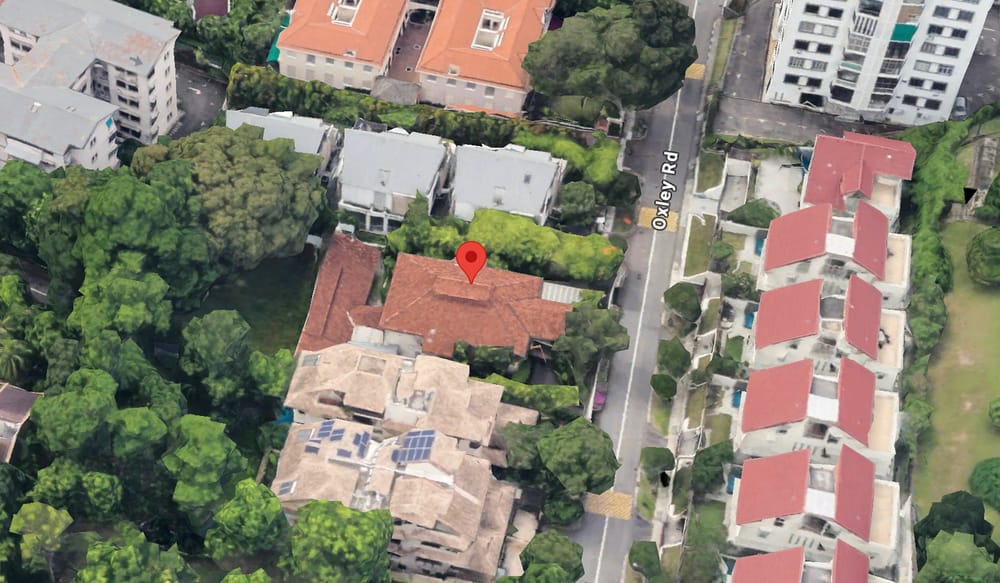With the recent resurgence of the topic of race and racism in Singapore, I thought it was time to look at the most reliable source of information on this highly emotional subject - data. Quantifiable responses from a sufficiently large group of people are less prone (though not immune, of course) to bias and personal impressions stemming from anecdotes or both ideological and political beliefs.
This is particularly important when scores of people try to use every controversy, blowing it out of proportion for their own dubious sociopolitical goals, portraying Singapore as some hellhole where minorities are systemically oppressed.
As I have said before, I don't think Singapore has any real problem with racism.
In fact - it is the most successful and peaceful multicultural, multiethnic, multireligious country in the entire world, where people of all origins, customs and beliefs occupy all strata in the society, are equally protected by the law and have equal opportunities to succeed in life.
(And if you think I am wrong, feel free to provide me with the name of any country that is better.)
The problem Singapore does have is not racism but the modern-dayperception of racism, often amplified (like most modern-day crises) by media coverage of isolated incidents that are merely exceptions to the rule.
With 24/7 news on TV and the internet, media focus on sensationalist stories while millions of positive interactions don’t get a minute in the spotlight. This creates a completely misleading picture of reality in people’s minds.
So, let’s look at the figures to see it more clearly.
The latest available survey on Race Relations was conducted by the Institute of Policy Studies of Lee Kuan Yew School of Public Policy in 2016 (side note: unbeknownst to most, it is also the source of the widely regarded as controversial, opinion of Heng Swee Keat that "older generation of Singaporeans not ready for non-Chinese PM" - which has been misleadingly circulated without context in the past 2 years, to portray the former PM-in-waiting and his party as racist, when he was really just citing survey results).
You can read it in full, here: https://lkyspp.nus.edu.sg/docs/default-source/ips/CNA-IPS-survey-on-race-relations_190816.pdf
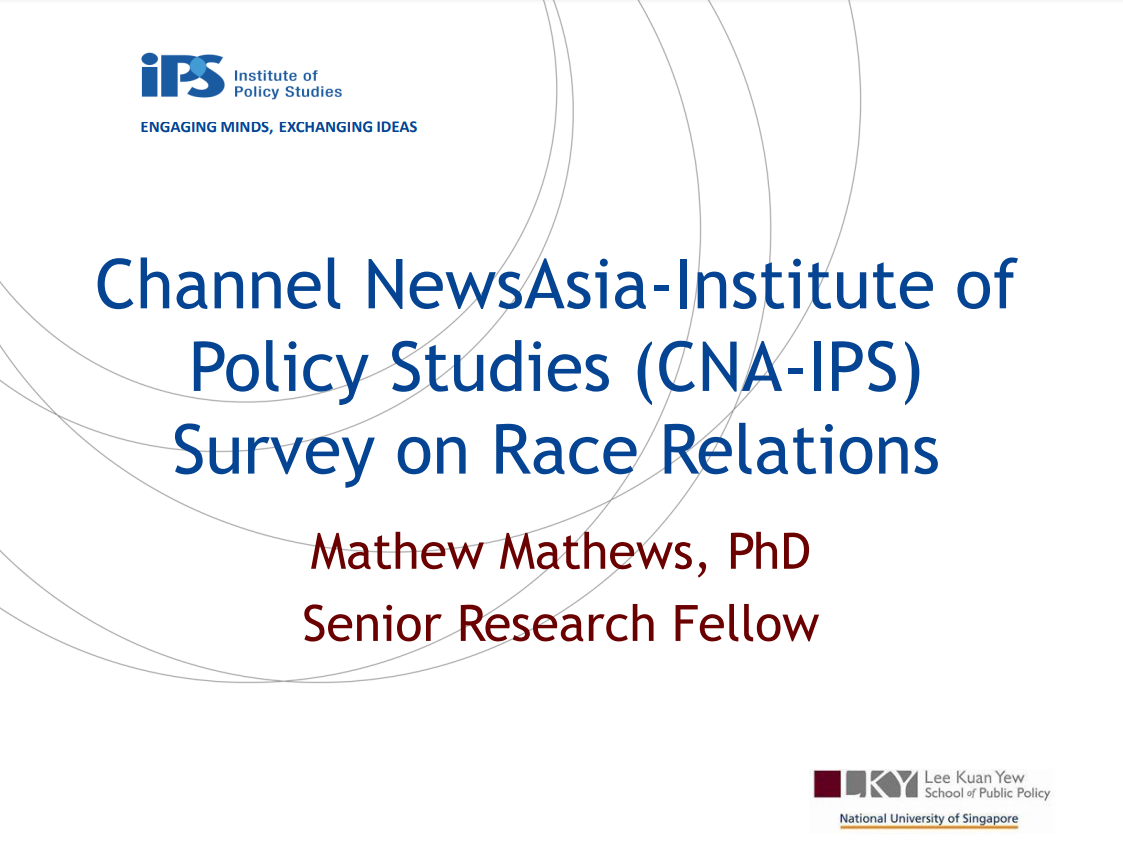
To understand the difference between racism and perceptions of it we have to evaluate it from two different angles:
- First is the perception of actual mistreatment - i.e. whether you were treated unfairly, others have treated you with superiority or perhaps you were a target of insults, threats or other harassment.
- Second, is the perception of the causes of this mistreatment - WHY do people think these negative experiences happened?
The former is fairly easy. It’s typically quite clear whether someone is rude or abusive towards you. However, the latter - whether his motivations were racist - is often just an assumption (unless it was explicitly verbalized by the offender).
Think of it this way - it's easy to tell when a restaurant waiter is rude to you - but whether he's just a rude guy, had a bad day or he is, actually, being racist can't be said for certain. If you are conditioned to think your race may be a problem you are more likely to see other people as being racially motivated, even if they aren't.
This is the gap in perception.
Let's first look at examples of negative treatments reported in the survey. Respondents - Singapore residents (citizens and PRs) - were asked to provide information about such incidents occurring in the preceding TWO YEARS, answering the following questions (I removed percentages for Other for clarity, as their portion in the society is quite small):
1. Being mistreated at a store or restaurant.

As you can see, 42% of Chinese and Malay Singaporeans and about 46% of Indian residents have received inferior service at least once in the last two years. The difference seems rather marginal.
2. When you felt people have seen you as inferior or themselves as smarter than you.

For these two questions, 36 to 46% of Chinese experienced condescending behaviour, compared to 50-56% of Malays and 48-54% of Indians - though more people among the minorities signalled individual rather than repeat incidents compared to the Chinese.
The differences are visibly larger, but it’s hard to call them a major gulf between the majority and the rest of the residents.
3. Insults and/or threatening behaviour.
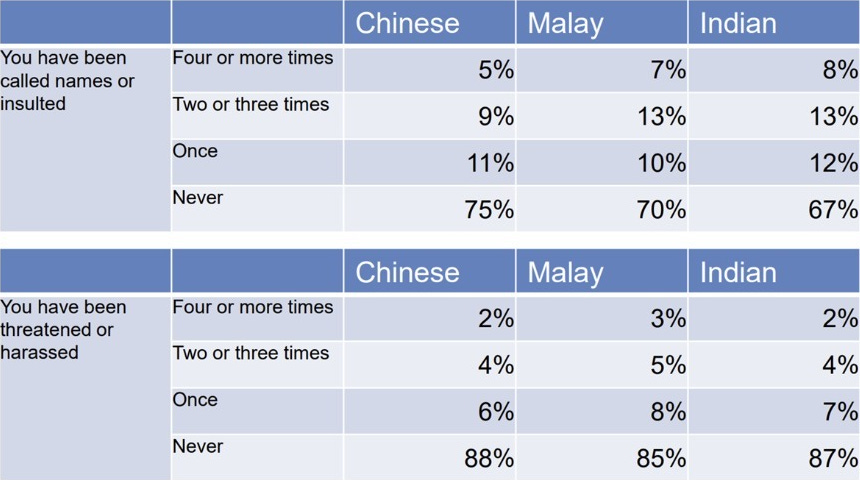
Finally, insults and threats are similarly rare for all. Slightly more Malays and Indians reported being insulted, but the difference is within single digits (25% Chinese vs. 30% Malays vs. 33% Indians).
As we can see, then, on the whole, the differences in reported mistreatment are fairly low, with surprisingly high incidence signalled by the Chinese majority (despite the divisive narrative of their alleged oppression of the minorities peddled by some).
There's a moderate difference in interactions involving condescension, with Malays and Indians more affected but not by a lot (10 to 14% more).
Alleged discrimination in Singapore is often blamed on the Chinese majority, but the survey suggests that, in reality, everybody is receiving a more-less equal share of negative experiences.
The perception gap
Let’s now take a look at the perceived reasons for this mistreatment.
After all, race doesn't have to be the only factor. Perhaps someone didn't like you, even if you represented the same race. It's hard to say why anybody acted negatively towards you unless it was explicitly said (which it most often is not).
Here is where we start to see real differences - the perception gap:
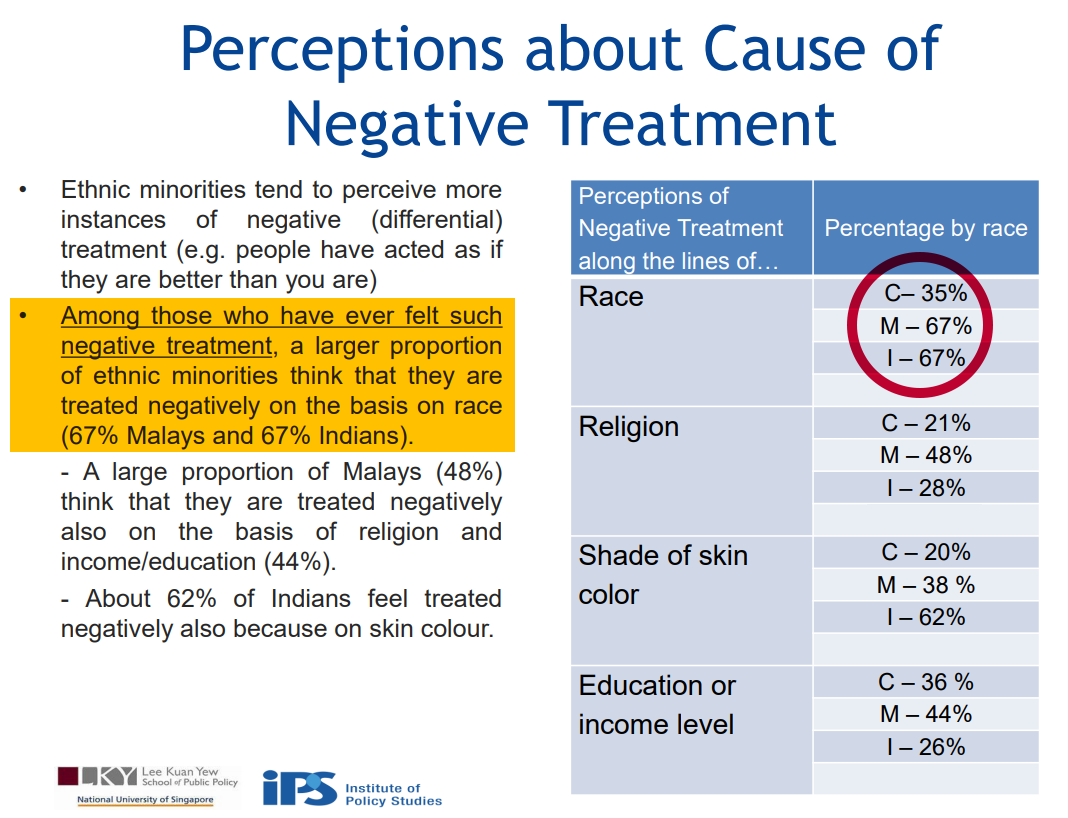
Out of those reporting negative treatment, 35% of Chinese but 67% of the minorities believed race was the factor driving the behaviour.
This proportion holds true across the entire population as well, with 17% of the Chinese vs. 33% of Malays and 36% of Indians reporting having felt racially discriminated at least once in their lives.
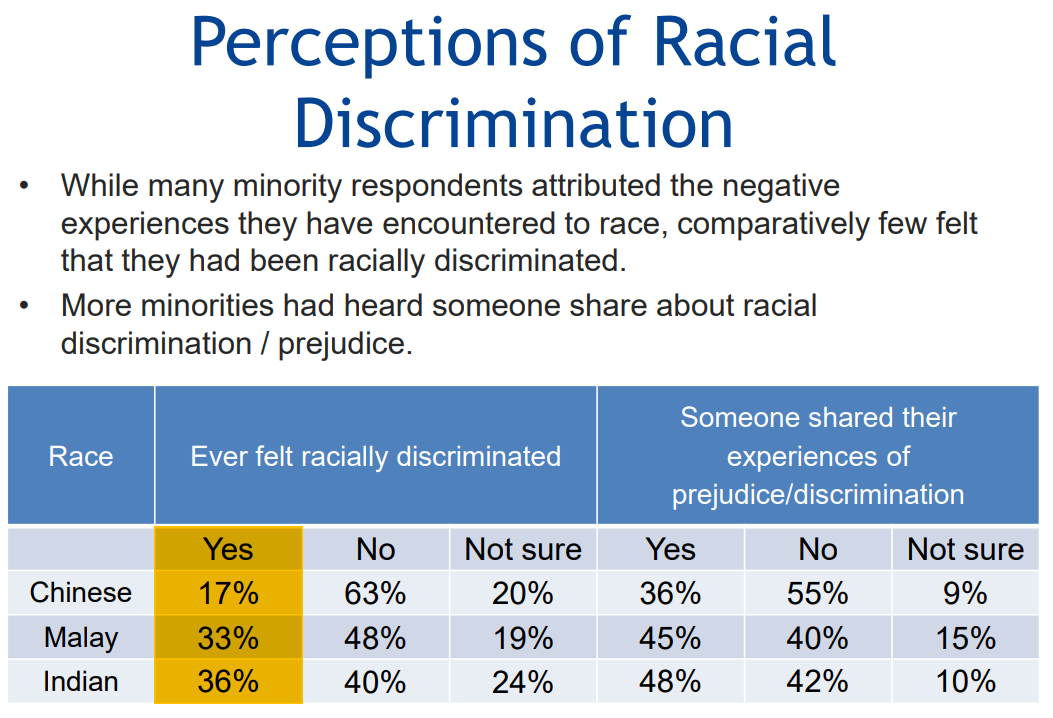
In other words, while all ethnic groups in the country are receiving comparable levels of negative treatment (with slightly more among minorities being victims of condescension), minorities are TWICE as likely to blame their bad experiences on racism.
The problem of lived experiences
At this point, many "progressives" like to talk about "lived experiences" and how we should unquestioningly believe victims reporting their experiences of racial discrimination.
The problem is, however, that if we are to take the lived experiences of everybody, as they have expressed through this survey, it would appear that minorities are more than FOUR times as likely to be racist against the Chinese than the other way around (!)
Singapore's resident population is around 4 million people, with 3 million Chinese and 1 million minorities.
17% of Chinese reported being racially discriminated in their lives - that is around 510,000 people. Around 35% of the minorities reported being racially discriminated against - so around 350,000 people.
For simplicity (since we have no specific data), let's assume that no racist incidents happened between minorities (i.e. Malay against Indian or Indian against Malay) - but that the Chinese majority is entirely responsible for all of them.
Even in such an extreme case, the Chinese would have discriminated against minorities at a rate of around 1 per 8.5 people, while minorities discriminate against the Chinese at a rate of 1 per 2 - more than four times higher.
If we were able to account for all incidents between Indians and Malays accurately, that ratio could grow even further.
One million people are responsible for victimizing half a million local Chinese, but 3 million Chinese would only be responsible (at the absolute maximum) for 350,000 victims in the opposite direction.
This is what happens when we take "lived experiences" at face value - when we "believe the victim". Well, if we are to believe all victims, it's the Chinese majority that is the target of far more discrimination.
It's probably one of the reasons why the "progressives" avoid speaking about figures and have insisted on framing the discourse using the methods transplanted from the West - as a conflict of the majority vs. minorities, where only the latter can claim victimhood.
This is also why Critical Race Theory is such a threat. It moves the focus of racial issues from individual incidents of racism - which can go either way - and stamping out the bad behaviour of the offenders onto the systemic level, where it claims the majority holds complete control, hence it cannot be victimized by racist behaviour.
(This is the reason why some in America keep saying that "you can't be racist against white people".)
In other words, the (crazy) idea is that even if people are not racist the entire country and its systems may be, because the majority is bound to rig everything against minorities.
As I argued in my previous article, responding to the local "loving critic" Alfian Sa’at who tried to use the same frame of argument, some people in Singapore seem to believe that, on this basis, it is impossible to be racist against the Chinese.
He has shown this line of thinking in one of his recent tweets, too and banned me when I pointed out his prejudice against the majority:

You see, the entire discourse is framed as if racism is a problem that minorities face at the hands of the majority rather than what it really is - individual incidents between people of various ethnicities that occur in different directions, not only with the Chinese as offenders and minorities as victims.
That's why racist incidents against the Chinese are not only not discussed but treated as something non-existent - when, as we can see from the survey, not only is it very much felt, but it is perpetrated at much higher rates than the alleged oppression of the minorities.
But is it really so?
The question is how the problem should be evaluated.
If we accept the "progressive" talking points and use them objectively - i.e. that we "believe all victims" - then we have to treat responses of respondents of all races equally.
In this case, it's clear that the reported racism against the Chinese is a considerably bigger problem as it is perpetrated by a smaller group of people with a relatively much greater frequency than in the opposite direction.
However, as I argued in my earlier posts, seen by many as controversial, the term "racism" has become so capacious that it can mean anything these days. Auschwitz gas chambers fall under "racism" just like modern-day "microaggressions" do - how can we operate under these conditions?
Given the demonstrable peace and prosperity of the Singaporean population, free from outbreaks of violence or visible destitution and marginalization of any ethnic group, one has to conclude that instances of what is understood as "racism" in the city-state don't really qualify to be called as such.
Let’s take the recent story of a Hari Raya cutout put up by the People’s Association in Tiong Bahru, which used a wedding photo of a Malay couple without their permission:
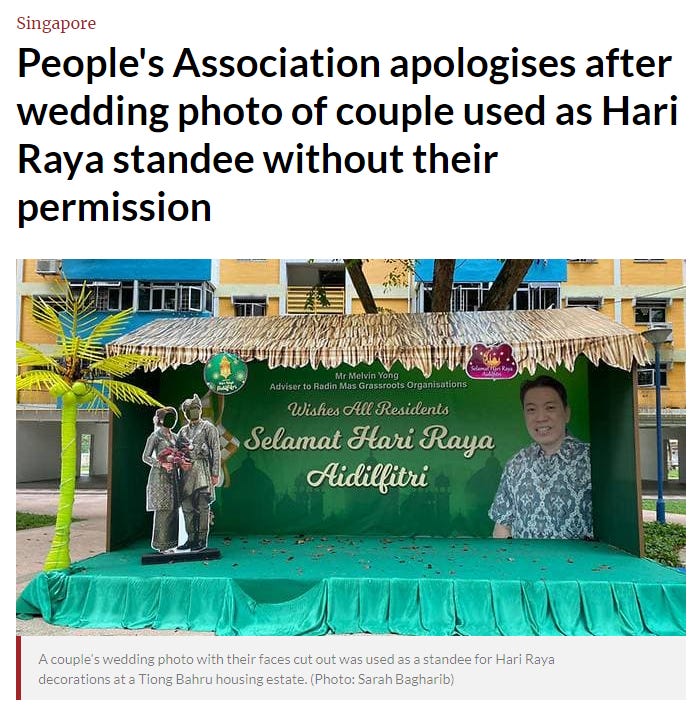
This is clearly an embarrassing mistake both for the PA and the vendor, who wanted to cut corners and just downloaded private photos from the internet, thinking that cutting out people’s faces would be enough to get away with not paying for the image.
It may also be inappropriate for the occasion, as the offended lady pointed out.
But at no point is it - as she has also claimed - driven by racism or racial discrimination or caricature of the Malays.
It’s silly to even suggest that, but sadly, many people have been conditioned to think that anytime something upsets them or they are a victim of somebody’s mistake, ill-will or crime, it must necessarily be due to their race, religion or skin colour.
As a result, self-reporting of what people believe is the cause of negative experiences is bound to be terribly skewed - as exhibited in the survey.
Minor incidents between people - which occur in EVERY SOCIETY IN THE WORLD - immediately get a label of intolerance and discrimination simply because they happened across ethnic boundaries.
This is why the only way to evaluate the state of racial harmony is through objective measures, facts, and figures - all corrected for specific cultural behaviours and different choices made by people within their ethnic setting.
Harbouring opinions about other people on the basis of their looks, demeanour, clothes and ethnic background is just a natural human trait. We are always going to have some observations about others as stereotyping allows us to make general sense of the world. We can’t intimately get to know every single person we meet in life - so we have to make judgments using imperfect methods and hedge our risks.
Having these views is not inherently racist and should never be treated as such.
What really matters is whether all ethnic groups have equal freedom to make the most of their lives:
- Do they receive similar access to schooling, healthcare, transportation?
- Do they have the same access to housing, particularly to publicly-funded estates?
- Can they pursue their selected careers, enjoy equal rights in access to jobs and are able to ascend in their chosen profession?
- Are they equal before the law?
- If there are any differences in career outcomes, are they a result of different personal choices or systemic factors?
If we look at income, for example, it turns out that the highest earning ethnic group are... Indians.
I don't have the latest figures b,t they surged past the Chinese by 2010 and by the most recent data from 2015, 12.5% of them live in households earning $20,000 or more - compared to 12.8% for Chinese and just 2.3% for Malays.

Malays seem to be lagging behind economically - but is it due to racist, systemic factors? If that was so, then why are Indians above the Chinese majority?
Is it due to discrimination or rather different life choices, which see Malay families marry earlier (what affects career prospects), have more children, and see more women stay at home to take care of the kids or only work part-time?
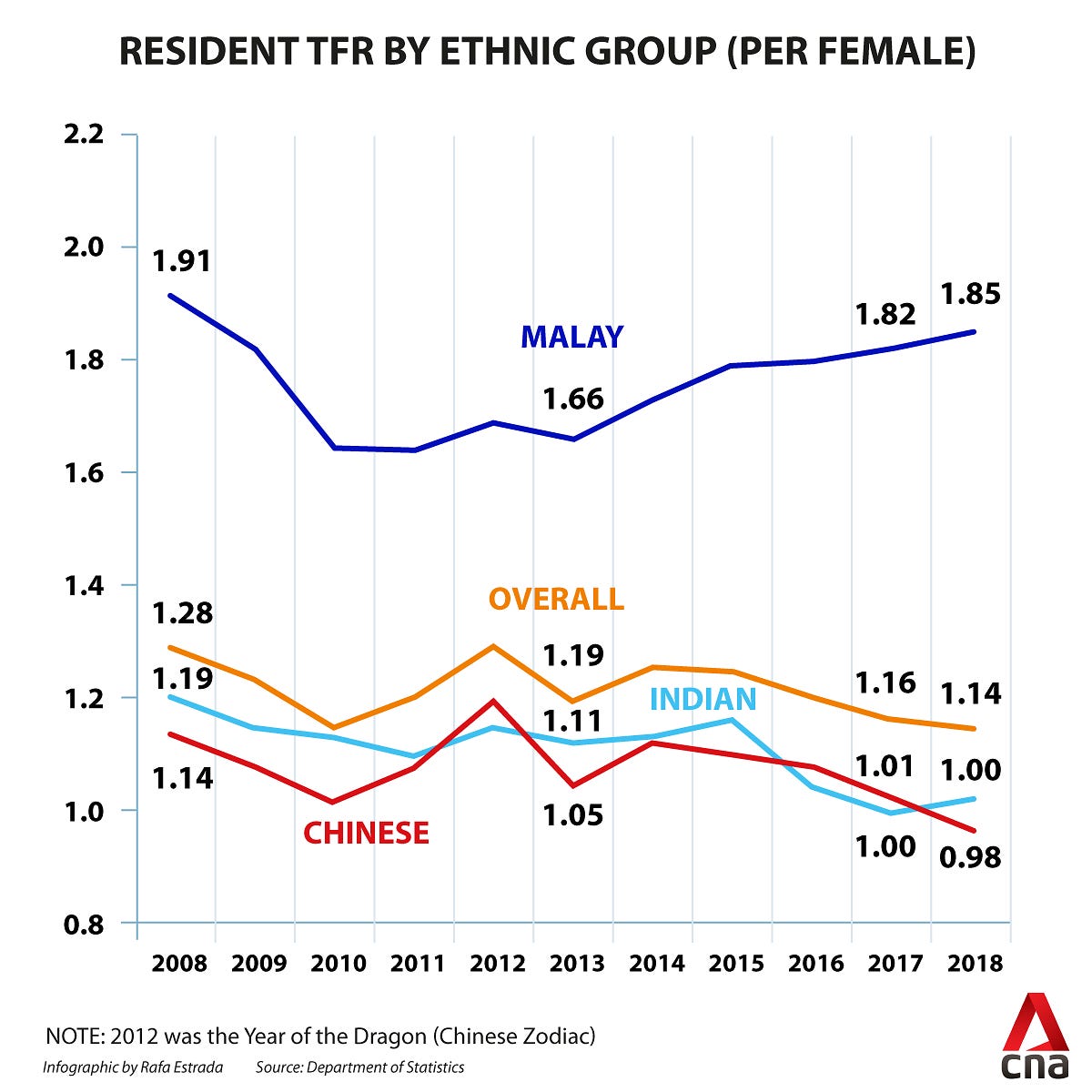
You would be hard-pressed to find any factual, data-backed indication that any racial group in Singapore is demonstrably discriminated against in a regular fashion.
It doesn’t mean, of course, that there are no incidents between individuals - but you’re bound to have them no matter where you live. Even ethnically homogeneous nations see stereotyping based on the domestic origins of a person (think of different regions in China, the rivalry between Tokyo and Osaka in Japan, Coast-Interior or East-West Coast divide in the USA, North-South in Italy - and so on).
So, don’t make everything about race.








